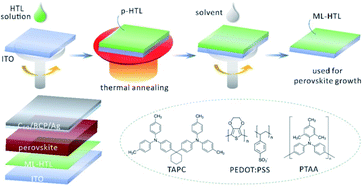Approaching optimal hole transport layers by an organic monomolecular strategy for efficient inverted perovskite solar cells†
Abstract
Recently, prominent works using organic monomolecular layers (MLs) as efficient hole transport layers (ML-HTLs) in inverted perovskite solar cells (PSCs) have been reported to evidently promote device performance; however, these results were achieved individually on specific organic molecules and the power conversion efficiency (PCE) was less than 20%. Herein, to explore the feasibility of extending the strategy of organic ML-HTLs to efficient PSCs and the underlying general enhancement mechanism as well as further optimizing devices to achieve competitive performances, we report an universal ML-HTL strategy, employing MLs of widely used organic hole transport materials to construct HTLs, including small molecules and polymers that are hydrophobic/hydrophilic in nature. This strategy enabled optimal MLs to be formed on ITO substrates with full coverage; meanwhile, the optimal ML thickness resulted in maximum reduction of the charge carrier transit time. Generally, the ML-HTLs not only improve the wettability of the perovskite precursor that favors the formation of compact perovskite films, but also raise the effective work function of ITO towards better energy level alignment by the formation of interface dipoles. Consequently, a substantially improved fill factor of 81.86% and a champion PCE of 20.58% were achieved with the hydrophobic small molecule ML-HTL, which are record values ever reported for inverted PSCs based on ML-HTLs. Apart from small molecules, the use of ML-HTL based on either hydrophobic or hydrophilic polymers also showed improved performances. Furthermore, the better shrouded and more compact perovskite films on ML-HTLs increased the reproducibility of PSCs, which is beneficial for commercial applications. This work demonstrates the totality and in-depth understanding of the ML-HTL strategy and its potential for the development of highly efficient inverted PSCs.



 Please wait while we load your content...
Please wait while we load your content...